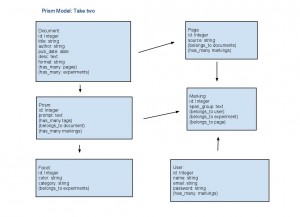Model vocabularies
Annie drafted a new Model for Prism this week, and we had a chance to tweak it and refine it on Friday. It was our first time programming together. Heck, it was the first time I ever programmed with anyone, period. We eased into the 24-inch monitor with some takeout Chinese. Patiently maneuvering one hand on the keyboard and one on the combination fried rice, we were able to create something close to the following diagram:
When we had more or less finished, we posted it on the IRC to discuss with whoever was online. We found Bethany, Eric R. and Jeremy. In the discussion, two suggestions came up which I think are important to keep in mind as Prism moves forward. Originally we had the model now named ‘Prism’ named ‘Experiment.’ The concern there was that the word was not catering to a humanist audience, or at least that part of it that understands itself outside the boundaries of science. In the same spirit, the field now named ‘prompt’ was originally named ‘research_question’. The other concern was over the use of the word ‘Tag’. That was the original name of the model now named ‘Facet’. The concern there was that the word brings with it its own semantic baggage, which might confuse the user. The new choices, ‘Facet’ and ‘Prism’, have the added advantage that they bring the color of Prism into the data models.
Something happened in that conversation. I realized that in order to be descriptive with data or objects, I don’t have to be clinical. I had realized the same for prose a while back, but it took this exercise to see what’s good for literature is good for code. Now I am ready to understand the full extent of the claim that code is an expressive language. Even if we will only have a few opportunities to share the language of the model with a general audience (a paper or conference talk here and there), we should code whenever possible with a humanist’s ear.

